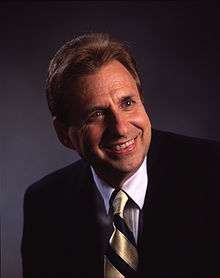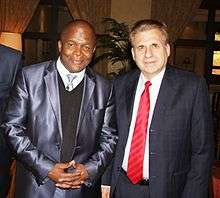John D. Kasarda


John D. Kasarda is an American academic and airport business consultant focused on global competitive strategy and aviation-driven economic development. He is currently Director for the Center for Air Commerce at the University of North Carolina's Kenan-Flagler Business School and CEO of Aerotropolis Business Concepts LLC, an airport-economy consulting firm.[1] He also serves as the President of the Aerotropolis Institute in China[2] and as editor-in-chief of Logistics,[3] an international scholarly journal.
Kasarda fused his academic training in economics, business, and urban sociology to pursue research on urban form, organizational structure, airport development, and regional economic growth. Many of his 10 books and over 150 published articles synthesize two or more of these topics.
From 1980 to 1990, he chaired UNC's highly ranked Department of Sociology,[4] where he held the chaired position of Kenan Distinguished Professor.[5] In 1990, Kasarda moved to UNC's Kenan-Flagler Business School as Kenan Distinguished Professor of Strategy and Entrepreneurship, and Director of the Frank Hawkins Kenan Institute of Private Enterprise.[6] Over the following 22 years, he stewarded the Institute into a major center for the study of entrepreneurship, regional economic development, and global competitiveness, including helping establish the Kenan Institute Asia in Bangkok,[7] where he continues to serve on its board and executive committee.[8]
Upon stepping down from the Kenan Institute Directorship in 2012, Kasarda maintained his Kenan-Flagler faculty position and directorship of the Center for Air Commerce.[6] Much of his research and applied work since 2000 has addressed how aviation and airports impact the competitiveness and growth of firms, cities, and regions.[9][10] Through his work Kasarda developed[11][12] the “aerotropolis” model,[13][14][15][16][17][18] defining the roles of aviation and airports in shaping 21st-century business location, urban competitiveness, and economic growth.[19][20] In 2006, The New York Times highlighted the aerotropolis model as one of its "Ideas of the Year".[21] In 2010, Brazil awarded the State of Minas Gerais Grande Medalha of Inconfidência to Kasarda[22][23] for his contributions to the Belo Horizonte Aerotropolis.[24] In 2011, Time magazine named the airport-centered concept as one of the "10 Ideas that Will Change the World."[25] His theories and applied work were elaborated in a book co-authored with Greg Lindsay, Aerotropolis: The Way We'll Live Next, released in March 2011 by Farrar, Straus and Giroux.[26] In 2013, Future Cities magazine named Kasarda one of the Top 100 City Innovators Worldwide.[27] In 2015, Dr. Kasarda received China's 1000 Foreign Talents[28][29] national award for his work as Chief Adviser to the Zhengzhou Airport Economic Zone, an aerotropolis covering 415 km2.[30][31][32][33][34]
Kasarda has consulted on numerous aerotropolis developments around the world, though his most extensive efforts have been in China.[35][36][37][38]
His model has its critics.[39] In fact, there is now a Global Anti-Aerotropolis Movement.[40] Nevertheless, its application has been steadily expanding internationally, from Amsterdam, Dubai, and Johannesburg to Memphis, Paris, and Zhengzhou.
Education
Kasarda earned a Bachelor of Science degree in Applied Economics from Cornell University in 1967, a Masters of Business Administration degree in Organizational Theory from Cornell in 1968, and a Ph.D. in Sociology from the University of North Carolina at Chapel Hill in 1971.
References
- ↑ "Aerotropolis Business Concepts LLC".
- ↑ "航都院". www.aicthink.com. Retrieved 2016-08-23.
- ↑ "Logistics". mdpi.com. Retrieved 2016-08-23.
- ↑ "Best Sociology Programs | Top Sociology Schools | US News Best Graduate Schools". grad-schools.usnews.rankingsandreviews.com. Retrieved 2015-08-27.
- ↑ "The Daily Tar Heel from Chapel Hill, North Carolina · Page 4". Newspapers.com. 8 September 1989. Retrieved 2015-08-27.
- 1 2 "John Kasarda | Faculty UNC Kenan-Flagler Business School". www.kenan-flagler.unc.edu. Retrieved 2015-08-27.
- ↑ "Jack Kasarda - Faculty Profile - Strategy and Entrepreneurship - UNC Kenan-Flagler Business School". www.kenan-flagler.unc.edu. Retrieved 2015-08-27.
- ↑ "Kenan Institute Asia สถาบันคีนันแห่งเอเซีย - Dr. John D. Kasarda". www.kenan-asia.org. Retrieved 2015-08-27.
- ↑ "The Age of Aerotropolis | endeavors". endeavors.unc.edu. Retrieved 2015-08-27.
- ↑ Kasarda, John. "McGraw Hill Financial | Gateway Airports: Commercial Magnets and Critical Business Infrastructure" (PDF). www.mhfi.com. Retrieved 2015-08-27.
- ↑ "Logistics & the Rise of the Aerotropolis". Real Estate Issues: 43–48. Winter 2000–2001.
- ↑ Kasarda, John D. (2000). "Aerotropolis: Airport-Driven Urban Development". ULI on the Future: Cities in the 21st Century. Washington, D.C.: Urban Land Institute.
- ↑ Mihm, Stephen (Dec 10, 2006). "The 6th Annual Year in Ideas; The Aerotropolis". New York Times Magazine.
- ↑ Lindsay, Greg (July–August 2006). "Rise of the Aerotropolis". Fast Company.
- ↑ England, Vaudine (March 16, 2006). "Free Flow: All the world's roads may lead to aerotropoli". International Herald Tribune.
- ↑ "Aerotropolis' to Make a Major Impact on Commercial Development". EC&M. Dec 1, 2005.
- ↑ "Business on the Fly". Economist. Nov 24, 2005.
- ↑ Nasser, Haya El (Sep 25, 2003). "New "cities" springing up around many U.S. airports". USA Today.
- ↑ "FEATURE STORY: Aerotropolis - Landing In The Heart Of 21st Century Urban Planning". Retrieved 2015-08-27.
- ↑ Byrnes, Nanette (19 August 2007). "Home Is Where The Airport Is". Bloomberg BusinessWeek. Retrieved 2015-08-27.
- ↑ Mihm, Stephen (2006-12-10). "The Aerotropolis". The New York Times. ISSN 0362-4331. Retrieved 2016-11-29.
- ↑ "DOEMG 20/04/2010 - Pg. 2 - Executivo | Diário Oficial do Estado de Minas Gerais | Diários Jusbrasil". Jusbrasil. Retrieved 2016-08-23.
- ↑ "Tribunal de Justiça Militar do Estado de Minas Gerais - Presidente do TJMMG e juiz da 2ª instância recebem, neste momento, a Medalha da Inconfidência 2010.". www.tjm.mg.gov.br. Retrieved 2016-08-23.
- ↑ "Aerotrópole de Confins começa a atrair novos negócios". Hoje em dia. Retrieved 2016-08-23.
- ↑ Iyer, Pico (17 March 2011). "Think of Your Airport as a City — but Nicer - 10 Ideas That Will Change the World - TIME". TIME.
- ↑ Kasarda, John; Lindsay, Greg (2012). Aerotropolis: The Way We'll Live Next. Farrar, Straus, and Giroux. ISBN 978-0374533519.
- ↑ "Future Cities Report - Top 100 City Innovators Worldwide".
- ↑ Huang, Liang (2015-06-11). "我省引进的外国专家分别入选: 国家"外专千人计划"和"高端外国专家项目"". The People's Government of Henan Province. Henan Province Governmental Office. Retrieved 2016-09-05.
- ↑ "我省引进外国专家入选第五批"外专千人计划"". 河南省外国专家局. Henan Administration of Foreign Expert Affairs. 2015-06-18. Retrieved 2016-09-05.
- ↑ "Around China: American professor helps develop aerotropolis in C". www.chinadaily.com.cn. China Daily. 11 July 2013. Retrieved 2015-08-24.
- ↑ "Aerotropolitan ambitions". The Economist. ISSN 0013-0613. Retrieved 2015-08-24.
- ↑ Jaggi, Rohit (2015-05-26). "Aerotropolis economic zones brace for take-off". Financial Times. ISSN 0307-1766. Retrieved 2015-08-24.
- ↑ Powell, David (May 26, 2015). "'Aero-tropolis' grows near city". South China Morning Post. Retrieved August 23, 2016.
- ↑ Kasarda, John (November 2015). "China's Dynamic Airport Economic Zone". Site Selection: 74–77. Retrieved August 23, 2016.
- ↑ "Aerotropolis Business Concepts". aerotropolisbusinessconcepts.aero. Retrieved 2015-08-27.
- ↑ Hans, Edwin; Yin, Mike (December 2011). "Aerotropolis: The Way We'll Live Next?" (PDF). Atlantis. 22 (3): 12–14. Retrieved 24 August 2015.
- ↑ "Real Estate Annual Finland 2011". www.nordicum.com. Retrieved 2015-08-24.
- ↑ "The Rise of the Aerotropolis". Retrieved 2015-08-24.
- ↑ Charles, Michael B.; Barnes, Paul; Ryan, Neal; Clayton, Julia (2007-11-01). "Airport futures: Towards a critique of the aerotropolis model". Futures. 39 (9): 1009–1028. doi:10.1016/j.futures.2007.03.017.
- ↑ "(no title)". antiaero.org. Retrieved 2015-08-27.
External links
- Kenan-Flagler Business School Faculty Biography for John D. Kasarda
- Aerotropolis.com
- Aerotropolis Business Concepts LLC
- Kenan Institute of Private Enterprise at the University of North Carolina, Chapel Hill